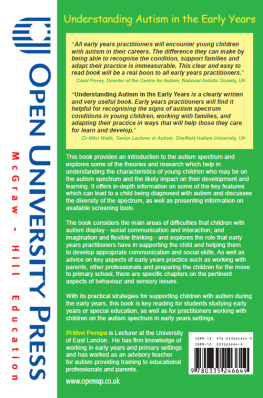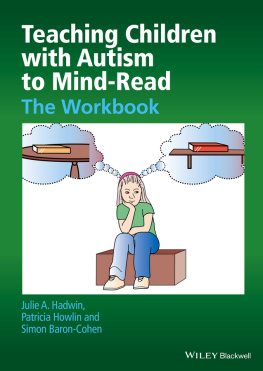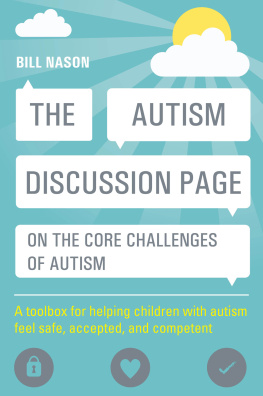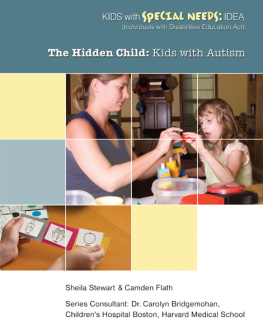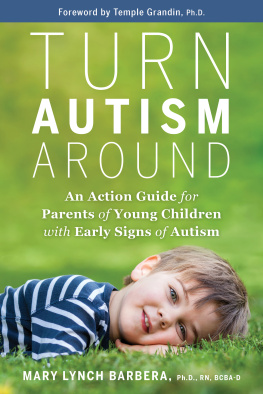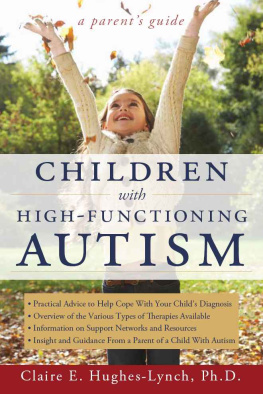Prithvi Perepa - Understanding Autism In The Early Years
Here you can read online Prithvi Perepa - Understanding Autism In The Early Years full text of the book (entire story) in english for free. Download pdf and epub, get meaning, cover and reviews about this ebook. year: 2013, publisher: McGraw-Hill Education, genre: Children. Description of the work, (preface) as well as reviews are available. Best literature library LitArk.com created for fans of good reading and offers a wide selection of genres:
Romance novel
Science fiction
Adventure
Detective
Science
History
Home and family
Prose
Art
Politics
Computer
Non-fiction
Religion
Business
Children
Humor
Choose a favorite category and find really read worthwhile books. Enjoy immersion in the world of imagination, feel the emotions of the characters or learn something new for yourself, make an fascinating discovery.
- Book:Understanding Autism In The Early Years
- Author:
- Publisher:McGraw-Hill Education
- Genre:
- Year:2013
- Rating:5 / 5
- Favourites:Add to favourites
- Your mark:
- 100
- 1
- 2
- 3
- 4
- 5
Understanding Autism In The Early Years: summary, description and annotation
We offer to read an annotation, description, summary or preface (depends on what the author of the book "Understanding Autism In The Early Years" wrote himself). If you haven't found the necessary information about the book — write in the comments, we will try to find it.
The book provides focus on three areas of difficulties for children with autism, as well as the role of early years practitioners.
Understanding Autism In The Early Years — read online for free the complete book (whole text) full work
Below is the text of the book, divided by pages. System saving the place of the last page read, allows you to conveniently read the book "Understanding Autism In The Early Years" online for free, without having to search again every time where you left off. Put a bookmark, and you can go to the page where you finished reading at any time.
Font size:
Interval:
Bookmark:

Understanding Autism in the Early Years
Understanding Autism in the Early Years
Prithvi Perepa

Open University Press
McGraw-Hill Education
McGraw-Hill House
Shoppenhangers Road
Maidenhead
Berkshire
England
SL6 2QL
email:
world wide web: www.openup.co.uk
and Two Penn Plaza, New York, NY 10121-2289, USA
First published 2013
Copyright Prithvi Perepa 2013
All rights reserved. Except for the quotation of short passages for the purposes of criticism and review, no part of this publication may be reproduced, stored in a retrieval system, or transmitted, in any form or by any means, electronic, mechanical, photocopying, recording or otherwise, without the prior written permission of the publisher or a licence from the Copyright Licensing Agency Limited. Details of such licences (for reprographic reproduction) may be obtained from the Copyright Licensing Agency Ltd of Saffron House, 6-10 Kirby Street, London, EC1N 8TS.
A catalogue record of this book is available from the British Library
ISBN-13: 978-0-335-24664-9
ISBN-10: 0-335-24664-8
eISBN: 978-0-335-24665-6
Library of Congress Cataloging-in-Publication Data
CIP data applied for
Typeset by Aptara, Inc.
Fictitious names of companies, products, people, characters and/or data that may be used herein (in case studies or in examples) are not intended to represent any real individual, company, product or event.
Praise for this book
This is a timely and very practical book addressed to all those working in early years settings who are working with, or who will be working with, children on the autism spectrum (i.e. all staff in any early years setting). It gives clear and authoritative information on current understanding of the autism spectrum, and draws on a wide range of literature to do so, while being written in a clear direct style that should be accessible to all. It would also be of benefit to family members who want to understand their child and how to best work with the systems and services they encounter. The book is realistic about the challenges but is also full of practical positive suggestions which respect the contribution of all to enabling effective practice: staff in the early years setting, support services, the family and, not least, the children themselves.
Professor Rita Jordan BSc.MSc.MA.PhD.C.Psychol.AFBPS.OBE, Emeritus Professor in Autism Studies, University of Birmingham, UK
Early years practitioners are absolutely vital partners in recognising autism and in adjusting their practice in response to the needs of children with autism. The impact they can make on families and outcomes for children is immeasurable, therefore a book like this which gives a mixture of practical strategies underpinned by evidence is a wonderful tool.
With a prevalence rate of 1 in 100 all early years practitioners will encounter young children with autism in their careers. The difference they can make by being able to recognise the condition, support families and adapt their practice is immeasurable. This clear and easy to read book will be a real boon to all early years practitioners.
Carol Povey, Director of the Centre for Autism, National Autistic Society
Understanding Autism in the Early Years is a clearly written and very useful book. Early years practitioners will find it helpful for recognising the signs of autism spectrum conditions in young children, working with families, and adapting their practice in ways that will help those they care for learn and develop.
Dr Mitzi Waltz, Senior Lecturer in Autism, Sheffield Hallam University, UK
To my Mum & Dad
Introduction to autism spectrum
Whether you have worked with children for a long time or you are entirely new to the field you must have heard about autism spectrum disorder (ASD). It is a phrase that is getting very familiar thanks to the media interest in the subject. However, the familiarity of the term is also producing misunderstanding and contradictory information about the subject. This chapter aims to provide an introduction to the condition by stating some of the basic facts.
Autism spectrum disorder (ASD) is a term used to cover a range of difficulties in two main areas of development. The term usually means difficulty in:
- social communication and interaction, and
- imagination and flexible thinking skills.
Until recently, the areas of communication and social interaction were considered as separate and the term triad of impairments was used to describe these three areas of difficulty, as suggested by Wing (1981). However, there are proposals for change in the diagnostic criteria, which will result in combining these two areas in the new Diagnostic Statistical Manual of Mental Health Disorders (DSM) edition V.
Autism spectrum is described as a developmental disorder. This means that it affects an individual during childhood. Hence, the symptoms are usually evident by 3 years of age, and this is indeed part of the current diagnostic criteria for both the International Classification of Diseases and Related Health Problems (ICD-10) published by the World Health Organization (2007) and the DSM-IV-TR published by the American Psychiatric Association (2000). Having said that, diagnosing children at such an early age is not always possible, especially for those with severe learning disabilities or with no associated learning difficulties. Let us look at two children to get an idea of how autism impacts on them.

At first glance it may appear that these children have different abilities, but both of them have been diagnosed as being on the autism spectrum. The reason the word spectrum is used is because of this disparity in the way it affects different individuals.
The discovery of autism spectrum
The idea of autism as a separate condition was developed in the early 1940s by two different professionals in two parts of the world. Leo Kanner was a child psychiatrist working in the USA and Hans Asperger was a paediatrician who lived in Austria. Leo Kanner coined the term early infantile autism in 1943, based on his work with a group of 11 children. Although Hans Asperger also wrote a paper called Autistic psychopathies in childhood in 1944, his work was not known to the English-speaking world until it was mentioned by Wing in an article of 1981 and later translated into English by Frith (1991). Asperger syndrome as a subcategory of autism was recognized only after this period.
Not having a separate category until the 1940s does not mean that autism did not exist before this time. In fact, there is evidence and hypothesis to identify many people who in hindsight could be described as being on the autism spectrum (Frith 2003). What this does mean is that until this time a child exhibiting difficulties in these areas would not have been diagnosed with autism.
Kanner and Asperger both believed that the children they were working with had above average intelligence. As our understanding about autism increased it became clear that this is not always the case and that some children with autism can and do have learning difficulties. Children who are diagnosed with high-functioning autism (HFA), Asperger syndrome or atypical autism may have average intelligence. It needs to be understood that children on the autism spectrum, just like any other child, may have other, additional disabilities such as learning difficulties, epilepsy, or a visual or hearing impairment as well as mental health issues. Having more than one condition is sometimes referred to as co-morbidity.
Next pageFont size:
Interval:
Bookmark:
Similar books «Understanding Autism In The Early Years»
Look at similar books to Understanding Autism In The Early Years. We have selected literature similar in name and meaning in the hope of providing readers with more options to find new, interesting, not yet read works.
Discussion, reviews of the book Understanding Autism In The Early Years and just readers' own opinions. Leave your comments, write what you think about the work, its meaning or the main characters. Specify what exactly you liked and what you didn't like, and why you think so.

